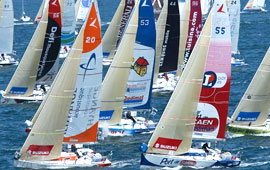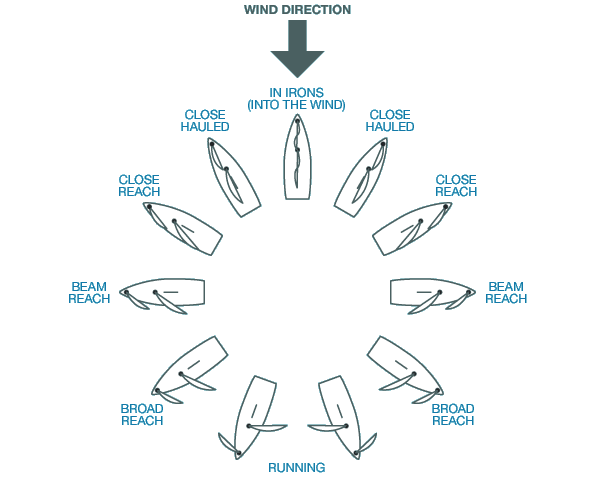edition #07
Points of Sail
During the month of June, Dee, her co skipper Anna Corbella and their crew will be participating in a racing tour of Spain. With the summer months stretching ahead of us and many boats taking to the water to enjoy the fine weather, we thought we would take a look at 'points of sail' in this months 'Did You Know' section of the website.

Points of sail describe a sailing boat's course in relation to the wind direction.
First, we need to look at the distinction between the port tack and the starboard tack. If the wind is coming from anywhere on the left side, the boat is on port tack. Likewise if the wind is coming from the right hand side, the boat is on starboard tack. Except when head to wind, a boat will be on either port or starboard tack while on any point of sail. For purposes of the racing rules and 'rules of the road,' the wind is assumed to be coming from the side opposite that which the boom is carried

Close Hauled
A boat is sailing close hauled when its sails are trimmed in tightly and it is sailing as close to the wind as it can without entering in irons. This point of sail lets the boat travel diagonally upwind. This is a precise point of sail. However, the exact angle relative to the wind direction varies from boat to boat. A boat is considered to be 'pinching' if the helmsman tries to sail above an efficient close-hauled course and the sails begin to luff slightly.
Reaching
When the boat is traveling approximately perpendicular to the wind, this is called reaching. A 'close' reach is somewhat toward the wind, and 'broad' reach is a little bit away from the wind (a 'beam' reach is with the wind precisely at a right angle to the boat). For most modern sailboats, reaching is the fastest way to travel. Different boats have different performance characteristics: on some boats, the beam reach is the fastest point of sail; on others, a broad reach is faster
Running Downwind
On this point of sail (also called running before the wind), the wind is coming from directly behind the boat. Because running is the most difficult point of sail for modern yachts, and can be dangerous to those on board in the event of an accidental jibe, it is often called the 'don't go zone'. Modern racing yacht design favors sailing rigs that can point very high to windward, which means a high aspect ratio sail. Downwind performance suffers, but that is overcome by the use of a low aspect ratio spinnaker for running.
When running, the mainsail is eased out as far as it will go. The jib will collapse because the mainsail blocks its wind, and must either be lowered and replaced by a spinnaker or set instead on the windward side of the boat. Running with the jib to windward is known as goose wing, or wing and wing. Cruising yachtsmen, when running downwind, will often set either a poled-out genoa or a pole-less cruising 'chute (or gennaker). When running downwind for protracted periods, for example when ocean-crossing in steady trade winds, cruisers sometimes set twin poled-out jibs without a mainsail. All of these options are more stable and require less trimming effort than a spinnaker.
Steering is difficult when running because there is often little or no pressure on the tiller to provide feedback to the helmsman, so the boat may easily go off course. This tendency to turn off course when running can be dangerous, as the boat is least stable and can jibe accidentally if the lee side of the sail catches the wind. A preventer can be used on yachts to avoid this.
did you know? archive
- edition #01 - A Great Sailing Read…
- edition #02 - Sailing Records
- edition #03 - Cordon Rouge Club
- edition #04 - Charitable Causes
- edition #05 - IMOCA Open 60
- edition #06 - Offshore Sailing Classes
- edition #07 - Points of Sail
- edition #08 - Sailing Dictionary
- edition #09 - Toe in the Water
- edition #10 - PSP Southampton Boat Show



